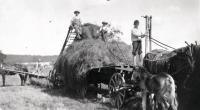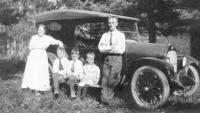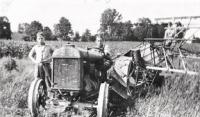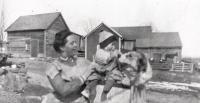Main Sections
Front Page
SportsValley VitalsIt's in the StarsStarwiseArchivesLinksAbout The VoiceContact Us
|
Sharing Memories Generations On The Land The Payne Farm In Cornwall

photo by Photo Provided Haying 1921. |
| 
photo by Photo Provided Paynes - Stella, Ralph, Ernest, Stanton & Alfred. |
| 
photo by Photo Provided Payne Boys - Ernest, Ralph,
Stanton, 1925. |
| 
photo by Photo Provided Stella Rachel (Foote) Payne and
my grandfather Ralph - 1911. |
| 
photo provided Logs cut for new Cow Barn 1911. |
|
Tuesday February 23, 2016
By Stephen R. Payne
The Payne farm was located on the northern edge of Cornwall, at the corner of Snake Mountain Road and Vermont Route 125. Five generations of Paynes lived here; but the later generations are also descended from families who have been in Cornwall for 8 and 9 generations – Footes, Binghams, Blodgetts, Gales and Danas among others.
Lyman Horace Payne came with his parents from Warren, Vermont to Addison County in 1837, eventually settling in Bridport. He was educated in the common schools of Shoreham and Bridport and the Academy in Shoreham. He remained at the home farm up until 24 years of age, when he went to California in the spring of 1859 and engaged in mining and farming. He returned from the Pacific Coast after 7 years and married Eliza Mary Dana of Cornwall. In the spring of 1869 he moved to the farm in Cornwall known as the Wooster Homestead, which consisted of 100 acres and the house was built by the Woosters in 1784. He was a successful farmer, sheep; raiser and a great horseman. Both he and his wife are buried in the Lemon Fair Cemetery, just a few steps from their home.
Early history of the farm taken from: "The History of Addison County, Vermont", p. 427 - "On the Wooster farm, so called, just north of the Lemon Fair bridge, William Dwinell first built his log cabin near a spring on the east side of the road. He sold this farm to Deacon Amzi Jones, and he to Moses Wooster, who came from Virginia. He fought in the Revolution and was captured on Long Island, treated cruelly, and at a later day was confined in New York, where he was nearly starved on damaged provisions. The farm is now in the hands of L. H. Payne."
To update this account: the farm passed from Lyman Horace Payne to Alfred Lyman Payne, then Ralph A Payne, Sr., then sold by my grandmother, Margaret A (Palmer) Payne to Jack & Helen Whipple in c. 1967. Jack sold to someone who restored the house and re-sold it again. All the barns & sheds have been pulled down - old cow barn, new cow barn, 3 silos, the old granary. Some of the land is still being farmed (Audet's Blue Spruce Farm in Bridport) and some has been conserved for wildlife. Huge flocks of Canada and Snow geese use “the flats” along the Lemon Fair river during their spring and fall migrations. The Lemon Fair is also home to beavers, muskrat, great blue herons, bull pout, carp, turtles and an occasional eel. My brother and I loved playing along the edge of the muddy stream and fished for all sorts of creatures.
My grandfather was a great man. His mother died in giving birth to the 4th son of the family. Grandpa was 15, and as the eldest child, was left to help raise his 2 younger brothers while working on the farm. Diabetes was a genetic heritage on the Payne side of the family; one of his brothers died at 17 of it, Grandpa died just short of his 56th birthday of complications of the disease when I was only 7. This means that many of my memories of my grandfather come from stories I was told, but I do remember riding with him in the big truck which they chopped corn for silage into in the big flat fields along the Lemon Fair and “helping” in the barn as he milked. Grandpa bought two neighboring farms, including the one where I still live.
Our family has numerous pictures of the generations of Paynes as they worked on the farm – photos of Dutch Belted cattle and then of the beautiful Jerseys my Grandparents introduced to the farm. My Grandmother was Margaret Palmer, who with her father and brother began the milk route which grew into Palmer's Dairy in East Middlebury. The Palmers had Jerseys, so the Payne farm switched over to this breed after my grandparent's marriage in 1930. We also have pictures of early iron wheeled tractors, a reaper used to cut grain, and various other farm activities: butchering hogs, loading loose hay into the haymow of the cow barn, a picture of the logs cut to build the “new” cow barn in 1911. The earlier generations of Paynes raised both Registered Merino sheep and fine driving and trotting horses; by my grandfather's day it was entirely dairy cattle.
Farming in Vermont in the 19th and 20th centuries was never easy, but rewarding in its own way. I have fond memories of searching for wildflowers in the woods, having picnic lunches up on “the hill” covered with Shagbark Hickory trees, picking “blackcaps” - wild black raspberries – just outside the windows of the barn. These memories are just the beginning and I could literally write pages.
(The Valley Voice salutes Stephen Payne for his documentation of the family farm and encourages all who share a passion for the land and their own past to begin the journey of finding out who you are and where your people come from.)
|
Advertisements
Search our Archives
|







 Printer Friendly
Printer Friendly